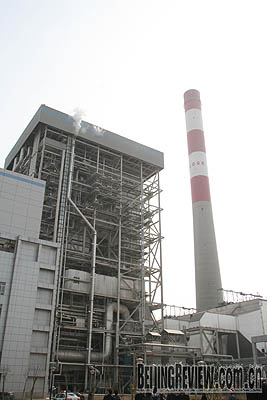|

COMING CLEAN: Phase 1 of Huaneng Tongchuan Power Plant, with an installed capacity of 1.2 million kw, was put into operation at the end of December 2007
YANG XUEQI
In January 2007, people in Tongchuan, Shaanxi Province, were surprised to see over 100 swans settling in the city for the winter. By comparison, more than a decade ago, the city was criticized by China Central Television as "an invisible city watching from a satellite" for its serious air pollution. "Now so many swans fly here for the winter, proving that the environment in Tongchuan has improved," said some amateur photographers from Xi'an who paid a special visit to Tongchuan.
Tongchuan, located in central Shaanxi Province, is an industrial city whose growth was fired by coal. The city is an important base in northwest China for coal mining and construction materials. The simple pattern of "excavating coal, quarrying, making cement and selling resources" used to prop up the city's economic development. "However, the extensive economic growth pattern of high energy consumption, high emissions and low efficiency didn't benefit the local economy, but led to serious pollution instead," said Wu Qianjin, Secretary of the Tongchuan Committee of the Communist Party of China.
According to information released by the local government, in the late 1990s when the pollution from dust was the most serious, an average of 35 tons of dust fell on every square km of land in the city each month and dense smog enveloped the urban area all year round.
Since 2003, the city has transformed its growth pattern by developing a circular economy and improving its economic structure. "We are focusing on comprehensive exploitation of resources, energy conservation and reduction of energy consumption and emission," said Wu. "By enhancing coordination among different industries, we have been concentrating our efforts on forming an industrial chain of a circular economy with coordinated production of coal, power, aluminum and cement," Wu continued.
According to Wu, the industrial chain is formed by generating electricity with coal, smelting aluminum with electricity and producing cement with coal cinder, hence realizinging a circular system and an appreciation of resources while reducing pollution and energy consumption.
Take Huaneng Tongchuan Power Plant (HTPP) as an example. With a total investment of 10 billion yuan ($1.43 billion) and a total installed capacity of 2.4 million kw, HTPP consumes 6 million tons of coal every year, leaving 1 million tons of coal cinder and 100,000 tons of gypsum. "Coal cinder is of low value, but the cost of disposing of coal cinder is high," said Wu. According to him, all the 1 million tons of coal cinder and 100,000 tons of gypsum are now reused by local cement works, saving the disposal expenses for power plants and reducing the costs for cement works that used to transport coal cinder from other cities. The electricity generated by HTPP directly supplies an aluminum company, greatly reducing the costs of electrolytic aluminum.
In terms of energy conservation and environmental protection, HTPP has also reached an advanced level in the country. According to information released by HTPP, its water consumption for production and its emissions of sulfur dioxide are 80 percent and 90 percent lower than those of power plants of the same size. Furthermore, all the industrial effluents can be recycled. Compared with the country's average coal consumption of 399 grams to generate every kwh of electricity, HTPP consumes only 303.9 grams, saving 262,900 tons of standard coal every year.
After its technical transformations, Shaanxi Tongchuan Aluminum Co. Ltd. (STAC) increased its production capacity from 55,000 tons to 250,000 tons, but its consumption of alternating current to produce each ton of aluminum has been reduced from 17,996 kwh to 15,314 kwh, according to information released by the local government. By adding high-efficiency sulfur sorbent during the coal burning process in its affiliated power plant, the company has cut its emission of sulfur dioxide by 30 percent, or 900 tons, every year. While raising its production efficiency by 10 times, STAC has realized zero pollution of asphalt smoke, hydrogen fluoride and dust. The power plant affiliated with STAC has an installed capacity of 50,000 kw and uses 560,000 tons of coal every year. Together with the direct power supply from HTPP, the costs of STAC on electrolytic aluminum are reduced by a large margin.
At the same time, STAC has also realized the recycling of wastewater. "Water for cooling down aluminum pigs is chilled and then recycled to cool down aluminum pigs again," Tuo Liuyi, Deputy General Manager of STAC, told Beijing Review. |
